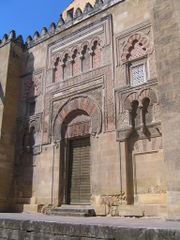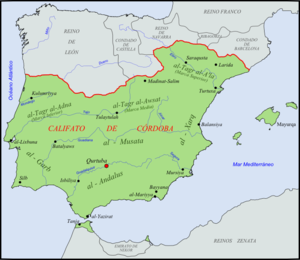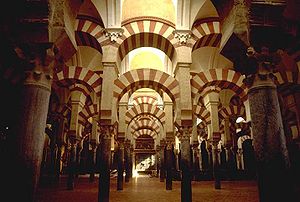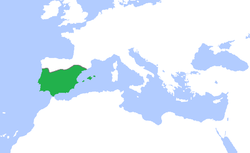Caliphate of Córdoba
|
|||||||||||||||||||||||||||||
| History of al-Andalus 711–1492
|
|---|
|
711–732 Invasions |
|
|
|
1039–1085 Taifas |
|
1085–1145 Almoravids |
|
|
1147–1238 Almohads |
|
|
1238–1492 Emirate of Granada |
|
| connected articles |
|
The Caliphate of Córdoba (Arabic: خلافة قرطبة Khilāfat Qurṭuba) ruled the Iberian peninsula (Al-Andalus) and North Africa from the city of Córdoba, from 929 to 1031. This period was characterized by remarkable success in trade and culture; many of the masterpieces of Islamic Iberia were constructed in this period, including the famous Great Mosque of Córdoba. In January of 929, Abd-ar-Rahman III proclaimed himself Caliph (Arabic: خليفة) of Córdoba[1] in place of his original title Emir of Córdoba (Arabic: أمير قرطبة 'Amīr Qurṭuba). Abd-ar-Rahman III was a member of the Umayyad dynasty; the same dynasty who held the titles of Emir of Córdoba since 756. The rule of the Caliphate is known as the heyday of Muslim presence in the Iberian peninsula. The Caliphate was practically disintegrated due to civil war (fitna) between descendants of the last legitimate Caliph Hisham II and the successors of his prime minister (hayib) Al-Mansur. The shell of the Caliphate existed until 1031 when, after years of infighting, it fractured into a number of independent Taifa kingdoms.[2]
Contents |
The Umayyad Dynasty
Rise
Abd-ar-Rahman I became Emir of Córdoba in 756; fleeing for six years after the Umayyads had lost the position of Caliph held in Damascus in 750. Intent on regaining a position of power, he defeated the existing Islamic rulers of the area who defied Umayyad rule and united various local fiefdoms into an emirate.[3]

Rulers of the Emirate were content to use the title emir or sultan until the 10th century, when Abd-ar-Rahman III was faced with the threat of invasion by the Fatimids, a rival Islamic empire based in Cairo. Partially to help in his fight against the invading Fatimids, who claimed the Caliphate in opposition to the generally recognized Abbasid Caliph of Baghdad, Abd-ar-Rahman III claimed the title of Caliph himself.[4] This move helped Rahman III gain prestige with his subjects, and the title was retained even after the Fatimids were repulsed.[5]
Prosperity
The Caliphate enjoyed immense prosperity throughout the 10th century. Abd-ar-Rahman III not only united al-Andalus, but brought the Christian kingdoms of the north, through force and diplomacy, under control. Abd-ar-Rahman stopped the Fatimid advance into Caliphate lands in Morocco and al-Andalus. This period of prosperity is marked by growing diplomatic relations with North African tribes, Christian kings from the north, with France and Germany, and Constantinople.[6] The death of Abd-ar-Rahman III led to the rise of his 46 year old son Al-Hakam II in 961. Al-Hakam II more-or-less followed in his father's footsteps, occasionally dealing with a few disruptive Christian kings and North African rebels, though trying not to be too severe. Unlike his father, al-Hakam's dependence upon his advisers was more distinct.[7]

Fall
The death of al-Hakam II in 976 marked the beginning of the end of the Caliphate of Córdoba. Before his death, al-Hakam named his 10 year old son Hisham II (976–1008) as successor. Seeing that the child was in no way competent to be Caliph, yet having sworn an oath of obedience to him, Al-Mansur Ibn Abi Aamir (the top adviser to Hisham's father, also known as Almanzor) pronounced him Caliph. Ibn Abi Aamir played guardian for the young Hisham, taking the Caliph's powers until he was of age. Instead, he isolated Hisham in Córdoba while systematically eradicating his opposition.[8] He steadily allowed Berbers from Africa to immigrate to al-Andalus in order to build up his base of support. Ibn Abi Aamir led a cruel regime compared to Abd-ar-Rahman III. He did not shy away from using force to keep the Christians in check. He, and eventually his son Abd al-Malik (al-Muzaffar), would continue to keep power from Hisham until 1008 when al-Muzaffar died and his brother (Abd al-Rahman) pushed to become the successor of Caliph Hisham; Hisham complied. On a raid in the Christian north, a revolt tore through Córdoba. Abd al-Rahman never made it back.[9][10]
The decision to name Hisham II Caliph shifted power from the individual to the advisers. The title Caliph became only a symbol; it no longer held power and influence. The Caliphate would be rocked with violence, with different revolutionaries claiming to be the new Caliph. The last Córdoban Caliph was Hisham III (1027–1031). With different factions competing, the Caliphate finally crumbled in 1031 into independent taifa kingdoms.
Economy
The economy of the Caliphate was very diverse and successful, primarily consisting of trade and plundering. State-sponsored raids into neighboring Christian kingdoms were very lucrative throughout the history of the Caliphate. Through the early years, tribute payments were made to Córdoba to guarantee safety. Muslim trade routes connected al-Andalus with the rest of the Mediterranean and beyond. There were many areas of industry that were revitalized during the Caliphate: textiles, ceramics, glassware, metalwork, and agriculture all benefiting the state. Tariffs were lucrative. Taxes imposed on Jews and Christians living within the Caliphate were another source of income.[11]
Culture

Córdoba was the cultural epicenter of al-Andalus.[11] Mosques, such as The Great Mosque, were the focal point of many Caliphs' attentions. Córdoba was the intellectual centre of al-Andalus, with translations of ancient Greek texts to Arabic, Latin and Hebrew. Appreciable advances in science, history, geography, philosophy and grammar occurred during the Caliphate.[12] Al-Andalus became susceptible to eastern cultural influences as well. Ziryab is credited on bringing hair and clothing styles to the Iberian peninsula (as well as toothpaste and deodorant).
List of rulers
Umayyad Emirs of Córdoba
- Abd ar-Rahman I, 756–788
- Hisham I, 788–796
- al-Hakam I, 796–822
- Abd ar-Rahman II, 822–852
- Muhammad I, 852–886
- al-Mundhir, 886–888
- Abdallah ibn Muhammad, 888–912
- Abd ar-Rahman III, 912–929
Umayyad Caliphs of Córdoba
- Abd ar-Rahman III, as caliph, 929–961
- Al-Hakam II, 961–976
- Hisham II, 976–1008
- Muhammad II, 1008–1009
- Sulayman II, 1009–1010
- Hisham II, restored, 1010–1012
- Sulayman II, restored, 1012–1016
- Abd ar-Rahman IV, 1017
The Ummayad dynasty was interrupted by the Hammudid dynasty:
- Ali ibn Hammud al-Nasir, 1016–1018
- Al-Qasim ibn Hammud al-Ma'mu, 1018–1021
- Yahya ibn Ali ibn Hammud al-Mu'tali, 1021–1023
- Al-Qasim ibn Hammud al-Ma'mu, 1023 (restored)
The Ummayad dynasty returned to power:
- Abd-ar-Rahman V, 1023–1024
- Muhammad III, 1024–1025
- interreign of Yahya ibn Ali ibn Hammud al-Mu'tali, 1025–1026
- Hisham III, 1026–1031
See also
- Caliphate
- History of Islam
- History of Portugal
- History of Morocco
- History of Spain
- List of Sunni Muslim dynasties
- Septimania timeline
Notes and references
- ↑ Simon Barton, A History of Spain (New York: Palgrave MacMillan, 2004), 38.
- ↑ Anwar G. Chejne, Muslim Spain: Its History and Culture (Minneapolis: The University of Minnesota Press, 1974), 43-49.
- ↑ Barton, 37.
- ↑ Barton, 38.
- ↑ Bernard F. Reilly, The Medieval Spains (Cambridge: Cambridge University Press, 1993), 84.
- ↑ Chejne, 35.
- ↑ Chejne, 37-38.
- ↑ Chejne, 38-40.
- ↑ Chejne, 42-43.
- ↑ Bernard F. Reilly, The Medieval Spains (Cambridge: Cambridge University Press, 1993), 87-89.
- ↑ 11.0 11.1 Barton, 40-41.
- ↑ Barton, 42.
|
||||||||||||||||||||||||||||||||
